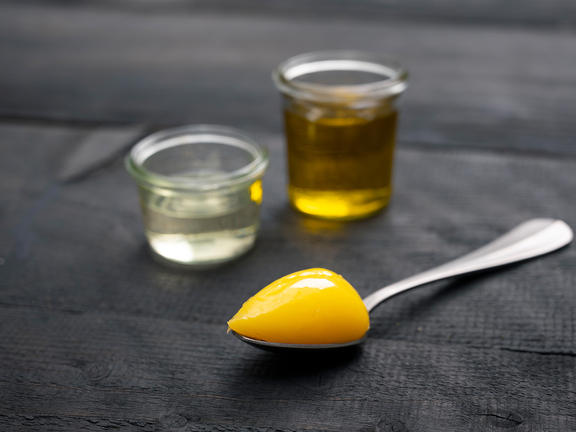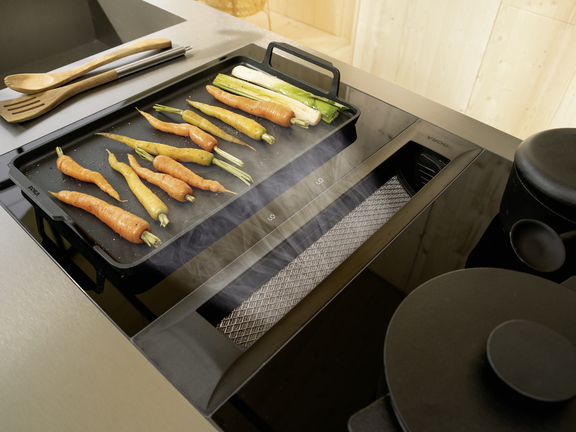

If you want to fry healthy, delicious dishes, oil is essential. Meat, fish, vegetables and more turn crispy on the outside and vegetable oils provide numerous healthy ingredients. What’s more, fat provides flavour and gives fried food a more intense aroma. But which oil is best and can cold-pressed oil also be used for frying? Here at BORA, we answer these burning questions.
When frying, it’s a question of heat: in the frying pan, temperatures get up to around 180 to 200 °C. At this heat, a crispy crust and a fond form that give your dishes a certain je ne sais quoi. The perfect frying oil can withstand this heat. If you want to use a healthy oil for frying, you should think carefully before choosing: knowing which oil is suitable for frying and what varieties are best used for cold dishes is the key to tasty, healthy dishes.
Cooker on, cookware at the ready and the frying fest can begin. But can meat and the like simply be fried in olive oil or should another fat be used? And which oil is the perfect choice for frying steak?
The type of oil you use for frying affects the quality of the food. The decisive factor in this regard is known as the ‘smoke point’: if the oil starts to smoulder, this is an unmistakeable sign that the fatty acids are being broken down. This can lead to the appearance of hazardous substances. This oil is then no longer suitable for frying.

When the smoke point is reached depends above all on the ingredients in the oil. Whilst some fatty acids are highly resistant to heat and only split when temperatures get very high, with others this happens at comparably low temperatures. Especially polyunsaturated fatty acids, which are considered to be healthy, prefer things a bit cooler: the higher the proportion of unsaturated fatty acids, the quicker the smoke point is reached.
In general, healthy oils are rich in polyunsaturated fatty acids. They are considered to have a positive effect on cholesterol levels and cell health. Conversely, excessive consumption of saturated fatty acids can be a risk factor for cardiovascular diseases and increasing cholesterol levels.
Frying oil is generally refined, that is, processed. These frying oils are obtained by applying heat and adding chemicals.On the one hand, this generates a greater yield; on the other hand, refined oils remain thermally stable. Producers then filter the substances used out of the end product. As a result, refined oils are not necessarily unhealthy.
However, the proportion of polyunsaturated fatty acids is also reduced and vitamins and flavour also suffer from the intense heating. Thus, refined oils often have a more neutral flavour than cold-pressed ones.
Good to know: natural, cold-pressed oils also include the term ‘virgin’ in the name.
You want to use healthy oil for frying but are faced with a large selection to choose from: to what temperature can the different oils be heated? The table below reveals all.
Oil variety | Smoke point |
Avocado oil | 261 °C |
Refined sunflower oil | 252–254 °C |
Refined peanut oil | 230 °C |
Refined rapeseed oil | 190–230 °C |
Refined sesame oil | 232 °C |
Refined olive oil | 216 °C |
Coconut oil | 194 °C |
Walnut oil | 140 °C |
Unrefined rapeseed oil | 130–190 °C |
Unrefined olive oil | 130–175 °C |
Linseed oil | 107 °C |
Brief and hot or a moderate heat and gentle cooking: different dishes require different temperatures. This also influences the choice of cooking oil. Which oil is ideal for searing and can cold-pressed oil also be used for frying?

Searing means, above all, briefly cooking meat at very high temperatures of 200 °C and over. Avocado oil and practically all refined oils are most suited to this purpose.
Vegetables and meat are sautéed at a lower heat from around 160 °C. If you stick with this moderate heat, some cold-pressed virgin oils can also be used for frying. These include olive oil and unrefined rapeseed oil.
Vegetables are optimally fried at 160 to 180 °C. This preserves many valuable ingredients and you can enjoy a subtle smoky flavour. Among others, coconut oil can be used for frying in this case. If you prefer a neutral flavour, use rapeseed oil for frying.
If you think carefully about which oil to use for frying, you can enjoy all of the health benefits and look forward to outstanding flavour. Here’s how to go about it:
Put the oil in the frying pan first. As soon as small bubbles form, the optimum temperature has been reached for adding the food you want to fry.
Keep the temperature constant so that the oil does not start to smoke.
Add virgin oils with a low smoke point like walnut oil and linseed oil to your dishes after cooking. This enables you to benefit from all their healthy ingredients.
You don’t always have to use oil for frying. Many dishes turn out great without using fat.
You can cook food in a non-stick frying pan without adding any fat. This works best with foods that already have a high fat content like meat and fatty fish. Bonus: fatty fish is rich in healthy omega-3 fatty acids.
Line the cookware with baking paper to prevent sticking.
Mineral water is a fat-free alternative to oil. Opt for more highly carbonated varieties and use the water sparingly so that a fond forms.
Whether refined or cold-pressed oils, they all need to be stored correctly. So that the oil stays flavoursome and fresh for a long time, we recommend bearing in mind the following:
Good to know: unopened bottles of oil can be kept for about a year. You should use opened bottles within four to six months.
Only add enough oil to the frying pan to just cover the base. This guarantees that food will be cooked evenly and nicely browned.
To sear meat, all refined oils like rapeseed and sunflower oil are suitable, as is coconut oil.
Olive oil is suitable for the gentle frying of vegetables, as are sunflower and rapeseed oil.
A variety with a neutral flavour like rapeseed oil brings out the flavour of fish dishes perfectly.